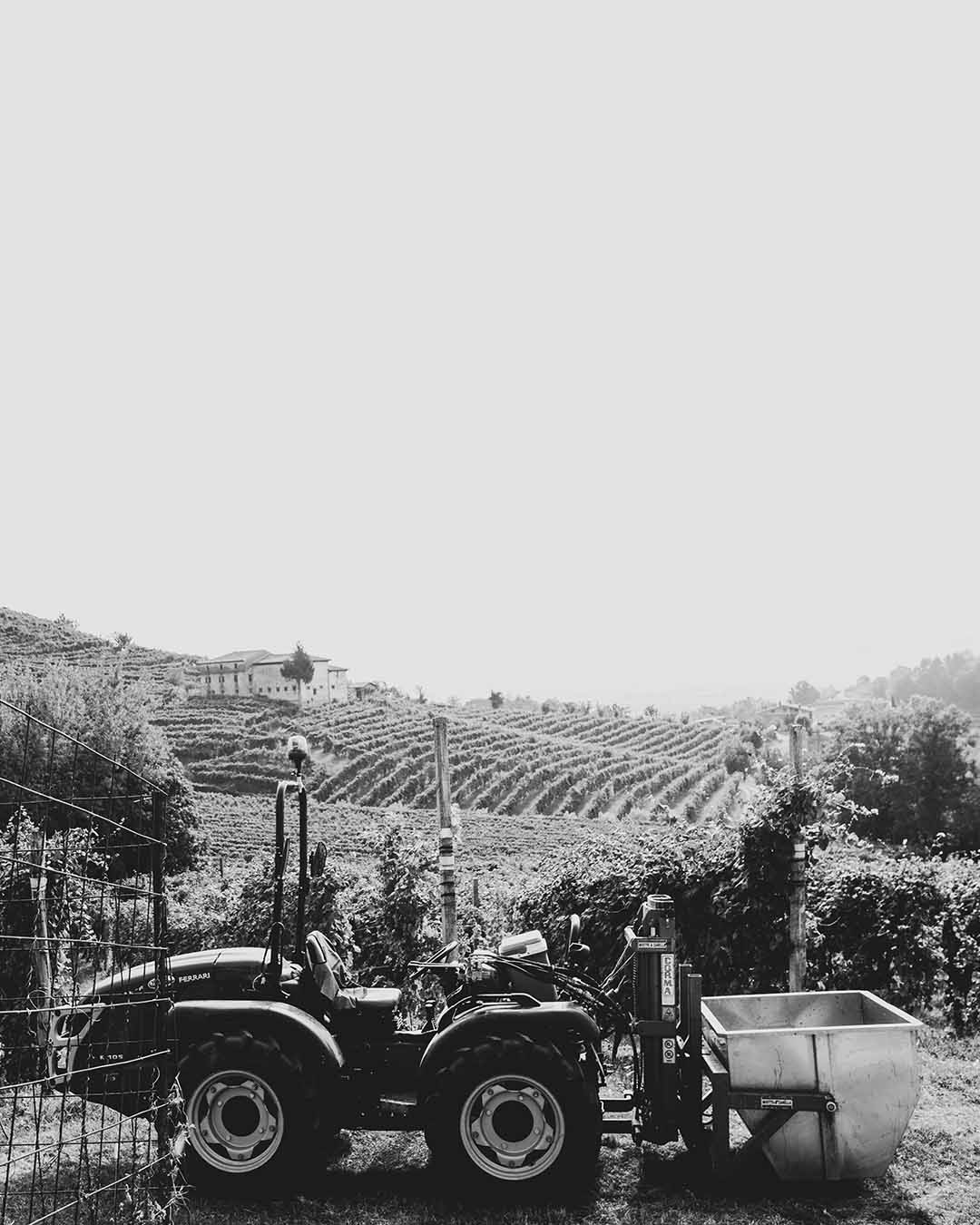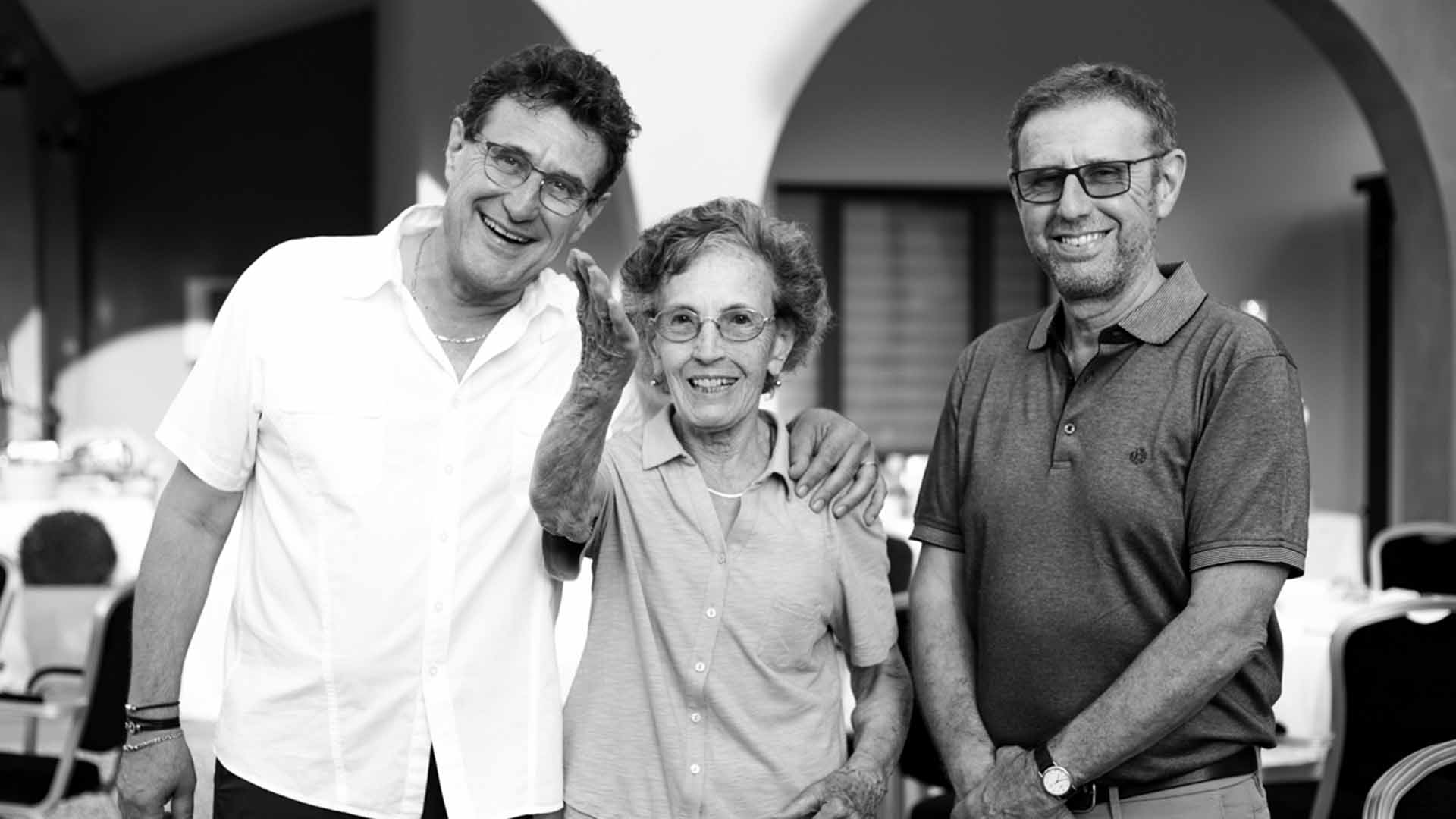The myriad facetes
of our family
HISTORY
Our deep, fertile roots
______
In 1920, grandfather Abele, already a grapegrower in Santo Stefano di Valdobbiadene, purchased from Conte Balbi Valier a magnificent, conch-shaped vineyard, at once gorgeous and rich with promise. A piece of land with which to begin afresh after the devastations of World War I, together with his children, , in a family known locally as “I Casei.” Abele “Casel” Adami had the extraordinary idea of separating this vineyard from the others, as he already had done with the Cartizze vineyard. It was an unusual intuition because it is rare to be able to sensitively capture nature’s whispers, observe and understand the very soul of places destined to produce true jewels. The fruit of this decision was something totally unknown in the history of our area: two wines produced and named as single-vineyard crus and bearing the names of their townships: Riva Giardino Asciutto and Riva Cartizze Asciutto. Adriano Adami, “Jano Casel”, Abele’s 13th and last son, inherited this Vigneto Giardino. The family history thereafter was one of generations striving to endow their oenology with all the rigour of a prestigious profession, and of accomplishments that won them attention on a European scale in the early 1980s, with Armando and Franco, and right afterwards on the international stage. Today, the fourth generation, in the persons of Fabrizio, Claudio and Cristina, are actively contributing, and brand exploration has now spread to four continents. The long arc of these years has seen an alternating succession of viticultural achievements and international accolades that have brought together winegrowing experts, wine lovers, and sector professionals, an opportunity-rich adventure in which excellence has always met challenges yet always emerged triumphant. The result has been a patrimony of a family, of a growing area, and of a community, a heritage that only 100 years of history can fashion.
PHILOSOPHY
Our work rests on solid foundations
______


Fully four generations of activities, in both vineyards and winecellar, across space and time, mean a wealth of values, beliefs, and expertise.
There is one constant that unites them, however, the synergy between vineyard, soils, climate, and man, an intimate interrelationship that runs like a common thread through every single vineyard and that transmutes itself into wide-ranging nuances of taste and qualities, different even on each side of every hillslope.
Gifted with this immense richness, our own primary task is to understand, assist, and express in our wines the wealth of nuances that natures provides us. That means beginning to write the history-book of a wine by first achieving a deep understanding of the land that yields it, and by knowing what the effects will be of each small decision about it, from the emergence of its vines to the concluding moment of its wine being bottled.
As a consequence, it is critical for us, since we grow grapes in different areas, each with its own one-of-a-kind, unmatchable characteristics, to vinify separately each vineyard parcel. Only in this way can we transmit unaltered the complex identity of each individual locus in a precious, inimitable oenological expression.
The 34 imprints and the single vineyards
______
Each year, a cornucopia of some 34 various kinds of wine, sourced from the same number of vineyards, are assembled in various combinations to fashion that final print, 34 different nuances that combine together to create that particular palate, refined and elegant; that particular nose, crisp, rich, and fruity that the names Bosco di Gica and Dei Casel conjure up to the wine lover. The Adami Style. Our near-obsessive attention in analysing the grapes and the fragrances of their musts has led to identifying a vineyard that, year after year, produces a wine full, broad, and complete across the palate and fully able to arouse excitement without the help of any complement. In our four generations of winemaking, we have had the honour of discovering two such sensory adventures, which we named Vigneto Giardino and Col Credas.

Bosco di Gica
Valdobbiadene Prosecco Superiore DOCG

Dei Casel
Valdobbiadene Prosecco Superiore DOCG

Vigneto Giardino
Valdobbiadene DOCG Rive di Colbertaldo

Col Credas
Valdobbiadene DOCG Rive di Farra di Soligo
INDIVIDUALS
We cherish genuine relationships
______

The values that inspire us are specifically family-based values, our firm beliefs, milestones that, like a compass needle, anchor and guide us in our decisions and shape our business culture. And family constitutes the very first of them. We are a hard-working, Italian family-owned and -directed operation, firmly convinced that our collective life-force resides in us as individuals. Then, authenticity should be a core value of every family, and so we believe in relationships carried out in simple, professional manner, and in every activity we prefer substance over form. This, in turn, requires a sense of humanity, or that combination of respect for and attention to the consequences of our actions as they impact others and the environment in which we live and act.

We are a family with deep roots in our local area, who have for generations now produced wine from our own vineyards and those of long-trusted growers. Tending our “garden,” the natural environment surrounding us, and the individuals in whose midst we live means encouraging and ensuring, with confidence, their feasible future in the “vineyards” of our shared traditions. For this reason, people are the focus of our attention, and this creates a closer, more attentive, congenial relationship with those who appreciate and savour our wines, or with those who have not discovered them yet. This is part of our well-articulated philosophy of life. As such, it certainly contributes to the convivial atmosphere around a well-laid table, where one rediscovers the value of relationships. It is also a way of fashioning future awareness: those who select, from all the wines available, a bottle of our wine to grace their table may be certain of having made an absolute-quality choice and of sharing an Italian style of life in which authenticity, beauty, and fine artisanal craftsmanship are the highest values.
SUSTAINABILITY
Respect for the future
______
Cover-cropping
with plants precision-designed for the needs of the vineyard.
Water
recycled for production processes and low water-use equipment.
Electrical energy
100% from renewable sources either produced internally or brought in certified
Sustainable packaging
with all-paper labels; for over 20 years, no PVC on our case-boxes, and bottle glass among the lightest in the market.
SQNPI certification
for low environmental impact, health-respectful cultivation.
Weather monitoring
QUIDO technology in the vineyard to reduce treatments and to irrigate vines only when needed
Weed-killers
Glyphosate eliminated years ago.
LEARN MORE
read
______
In the vineyard
1. We live in an area of rare beauty. We are determined to always to treat it with respect through increasingly sustainable viticultural practices made possible by the wise use of science and technology. We also want to transmit its landscape uncontaminated to future generations. From vine-training methods to vine-row space management, every single activity contributes to the well-being of every individual vine and to the authenticity of its fruits that grow in an all-natural, spontaneous environment. Over the years, abandonment of chemical weed-killers has yielded to a true stewardship of cover-cropping.
2. The carefully-calculated sowing of various species of grasses allows us to not only reduce our carbon footprint but to limit fertiliser use as well. This, in turn, contributes to soil improvement, since cover-cropping species fix in the soil nitrogen naturally present in the atmosphere, reducing the need for fertilisers. We firmly believe that such an ecosystem, with vines that witnessed the World Wars now in total synergy not only with the earth but with all their surrounding plant species, must be not simply preserved but helped to evolve and improve as well.
3. In combatting vineyard pests, we are careful in our use of every type of treatment, relying on Integrated Crop Management National Quality System.
Winemaking
4. Every step in the winegrowing process is conceived and performed not only for effectiveness and efficiency, or for reducing impact on the environment, but, wherever possible, for assisting the environment in a positive, healthy fashion.
5. Each step is also designed with an eye to minimising energy waste. For example, acquiring more insulated tanks for cold-storage of wine limits energy waste.
6. Use of detergents and cleaning solutions has been reduced to a minimum, and their disposal is carefully performed.
7. Water used in vinification and tank cleaning is collected, processed, and utilised in the vineyards, where its natural organic compounds are useful for preserving soil quality.
8. We abandoned over 20 years ago use of PVC in adhesives in our case boxes and on our bottle labels, while the bottles themselves are among the lightest for sparkling wines.
9. We practice near-obsessive separation of waste materials from our production processes.
10. With regard to electrical energy, a solar panel installation produces some 40 KW/h, about half our energy needs, and the remainder is purchased from a hydroelectric company.
SUSTAINABILITY
For the community
______
Exercising humanity is the moral duty of human beings. Far from being just a play on words, this constitutes a a true team spirit that springs from a shared belief, both in the family and in the winery: committing oneself to support others is our responsibility, a form of respect and awareness towards the community to which we belong, which gives us so much throughout our life. We believe therefore in social sustainability and inclusion, which are concretely applied locally in two projects that have always been person-centred, Casa Maria Adelaide da Sacco and I Bambini delle Fate.

Casa Maria Adelaide da Sacco (Maria Adelaide da Sacco House) is a community residential facility that cares for those with mental and multiple disabilities, assisting them to become autonomous, adaptable, and developed, all in an educational-family atmosphere. Within the context of their program, we have participated, since 2020, in the Cantine Solidali initiative. That, in turn, supports the Cassette degli Artisti, in which Casa members fashion hand-painted wooden gift-boxes for wine and small crafted items, unique creations that develop each individual’s abilities.

I Bambini delle Fate (The Fairies’ Children), a non-profit meeting the needs of autistic children and their families, includes FARCELA, an association whose mission is to promote social integration through introducing various types of autonomy for the children. which we have supported since 2010.
